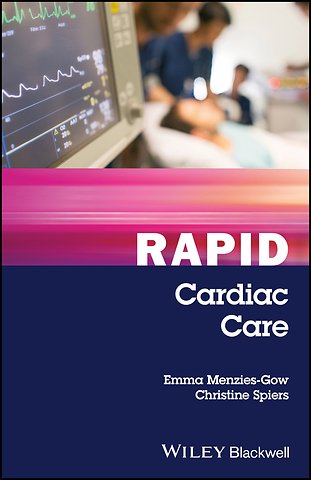Rapid Cardiac Care
Samenvatting
Rapid Cardiac Care is an indispensable resource for all frontline staff working with acutely ill patients. Offering easy access to the knowledge base needed to provide rapid, safe and effective cardiac care, it is ideal for newly qualified healthcare professionals including, nurses, paramedics, cardiac technicians, junior medics, and physiotherapists.
Key features include:
Essential information to support the assessment of the cardiac patient including focused history taking and physical assessment, rhythm interpretation and 12–lead ECG assessment
Practical guidance on how to care for patients with cardiac emergencies, including acute coronary syndromes, arrhythmias, heart failure and cardiac arrest
A quick reference A–Z section that explores a wide range of conditions affecting the heart, each with a comprehensive overview of patient presentation and strategies to guide patient assessment and management
Diagrams and images are provided to facilitate learning
Specificaties
Inhoudsopgave
<p>Preface, xii</p>
<p>Acknowledgements, xiii</p>
<p>Part 1: Cardiac Anatomy and Physiology</p>
<p>Anatomy, 3</p>
<p>Cardiac cycle, 5</p>
<p>Cardiac conduction system, 6</p>
<p>Coronary circulation, 8</p>
<p>Part 2: Rapid Cardiac Assessment</p>
<p>Introduction, 13</p>
<p>Cardiac history taking, 14</p>
<p>Physical examination, 18</p>
<p>Cardiac Monitoring, 21</p>
<p>Rapid rhythm recognition, 23</p>
<p>Cardiac investigations, 25</p>
<p>Part 3: Rapid 12 ]lead ECG Interpretation</p>
<p>Introduction, 31</p>
<p>Cardiac vectors and axis, 33</p>
<p>Rapid ECG analysis tool, 34</p>
<p>Rate and rhythm assessment, 35</p>
<p>QRS axis calculation, 36</p>
<p>Pre ]excitation syndromes, 37</p>
<p>Bundle branch block and fascicular block, 38</p>
<p>Myocardial ischaemia or infarction, 41</p>
<p>Other abnormalities seen on the 12 ]lead ECG, 44</p>
<p>Part 4: Cardiac Conditions A Z</p>
<p>Acute coronary syndromes, 47</p>
<p>Acute coronary syndromes: treatment and interventions, 51</p>
<p>Acute heart failure, 54</p>
<p>Aortic aneurysm, 57</p>
<p>Aortic dissection, 59</p>
<p>Aortic regurgitation, 61</p>
<p>Aortic stenosis, 63</p>
<p>Arrhythmogenic right ventricular cardiomyopathy, 65</p>
<p>Atrial fibrillation, 67</p>
<p>Atrial flutter, 69</p>
<p>Brugada syndrome, 71</p>
<p>Cardiac arrest, 73</p>
<p>Cardiac arrhythmias: treatment and interventions, 75</p>
<p>Cardiogenic shock, 79</p>
<p>Dilated cardiomyopathy, 81</p>
<p>Heart blocks, 83</p>
<p>Hypertension, 86</p>
<p>Hypertrophic cardiomyopathy, 88</p>
<p>Infective endocarditis, 90</p>
<p>Long QT syndrome, 92</p>
<p>Marfan syndrome, 94</p>
<p>Mitral regurgitation, 96</p>
<p>Mitral stenosis, 98</p>
<p>Myocarditis, 100</p>
<p>Pericarditis, 102</p>
<p>Supraventricular tachycardia, 104</p>
<p>Takotsubo cardiomyopathy, 107</p>
<p>Ventricular tachycardia, 109</p>
<p>Wolff ]Parkinson ]White syndrome (Pre ]excitation syndrome), 111</p>
<p>Index, 113</p>

